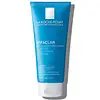La Roche-Posay Effaclar Shine Control Clay Mask Versus Clinique Anti-Blemish Solutions Oil Control Mask
What's inside
What's inside
 Key Ingredients
Key Ingredients

 Benefits
Benefits

 Concerns
Concerns

 Ingredients Side-by-side
Ingredients Side-by-side

Water
Skin ConditioningKaolin
AbrasiveArgilla
AbrasivePropanediol
SolventPanthenol
Skin ConditioningGlycerin
HumectantCaprylic/Capric Triglyceride
MaskingCI 77891
Cosmetic ColorantTitanium Dioxide
Cosmetic ColorantCetearyl Alcohol
EmollientZea Mays Starch
AbsorbentCellulose
AbsorbentCeteareth-20
CleansingLecithin
EmollientCaprylyl Glycol
EmollientCitric Acid
BufferingXanthan Gum
EmulsifyingTocopherol
AntioxidantPhenoxyethanol
PreservativeParfum
MaskingWater
Skin ConditioningKaolin
AbrasiveButylene Glycol
HumectantMagnesium Aluminum Silicate
AbsorbentSodium Lauroyl Sarcosinate
CleansingGlyceryl Stearate
EmollientPEG-100 Stearate
Gentiana Lutea Root Extract
Skin ConditioningLaminaria Saccharina Extract
Skin ProtectingSucrose
HumectantAlgae Extract
EmollientAloe Barbadensis Leaf Extract
EmollientSalicylic Acid
MaskingAcetyl Glucosamine
Skin ConditioningInulin
Skin Conditioning1,2-Hexanediol
Skin ConditioningCaprylyl Glycol
EmollientXanthan Gum
EmulsifyingDisodium EDTA
Chlorphenesin
AntimicrobialPhenoxyethanol
PreservativeCI 77891
Cosmetic ColorantWater, Kaolin, Butylene Glycol, Magnesium Aluminum Silicate, Sodium Lauroyl Sarcosinate, Glyceryl Stearate, PEG-100 Stearate, Gentiana Lutea Root Extract, Laminaria Saccharina Extract, Sucrose, Algae Extract, Aloe Barbadensis Leaf Extract, Salicylic Acid, Acetyl Glucosamine, Inulin, 1,2-Hexanediol, Caprylyl Glycol, Xanthan Gum, Disodium EDTA, Chlorphenesin, Phenoxyethanol, CI 77891
Ingredients Explained
These ingredients are found in both products.
Ingredients higher up in an ingredient list are typically present in a larger amount.
Caprylyl Glycol is a humectant and emollient, meaning it attracts and preserves moisture.
It is a common ingredient in many products, especially those designed to hydrate skin. The primary benefits are retaining moisture, skin softening, and promoting a healthy skin barrier.
Though Caprylyl Glycol is an alcohol derived from fatty acids, it is not the kind that can dry out skin.
This ingredient is also used as a preservative to extend the life of products. It has slight antimicrobial properties.
Learn more about Caprylyl GlycolCi 77891 is a white pigment from Titanium dioxide. It is naturally found in minerals such as rutile and ilmenite.
It's main function is to add a white color to cosmetics. It can also be mixed with other colors to create different shades.
Ci 77891 is commonly found in sunscreens due to its ability to block UV rays.
Learn more about CI 77891Kaolin is a clay. It is used for oil control and to help minimize pores. Like other clays, kaolin has the ability to absorb excess sebum or oil. This can help clean out pores and mattify the skin.
Some types of kaolin may have exfoliating properties. When water is added to kaolin, it becomes a paste with small abrasive particles.
Most kaolin is a white color, but may be pink/orange/red depending on where it comes from.
The name 'kaolin' comes from a Chinese village named 'Gaoling'. Kaolin clay comes from rocks rich in kaolinite. Kaolinite, the mineral, has a silicate layered structure. Kaolinite is formed from chemical weathering of aluminum siilicate minerals.
Besides skincare, kaolin is commonly used to make glossy paper, in ceramics, toothpaste, and as medicine to soothe stomach issues.
Learn more about KaolinPhenoxyethanol is a preservative that has germicide, antimicrobial, and aromatic properties. Studies show that phenoxyethanol can prevent microbial growth. By itself, it has a scent that is similar to that of a rose.
It's often used in formulations along with Caprylyl Glycol to preserve the shelf life of products.
Water. It's the most common cosmetic ingredient of all. You'll usually see it at the top of ingredient lists, meaning that it makes up the largest part of the product.
So why is it so popular? Water most often acts as a solvent - this means that it helps dissolve other ingredients into the formulation.
You'll also recognize water as that liquid we all need to stay alive. If you see this, drink a glass of water. Stay hydrated!
Learn more about WaterXanthan gum is used as a stabilizer and thickener within cosmetic products. It helps give products a sticky, thick feeling - preventing them from being too runny.
On the technical side of things, xanthan gum is a polysaccharide - a combination consisting of multiple sugar molecules bonded together.
Xanthan gum is a pretty common and great ingredient. It is a natural, non-toxic, non-irritating ingredient that is also commonly used in food products.
Learn more about Xanthan Gum